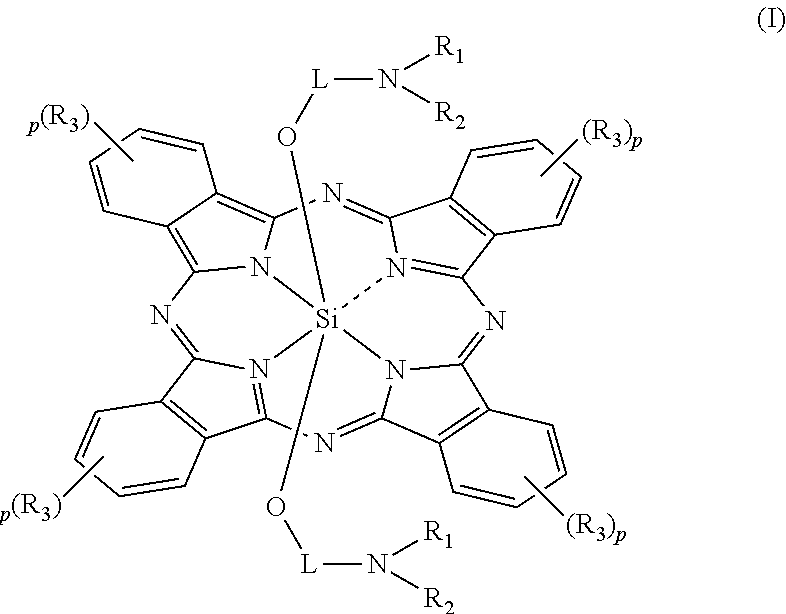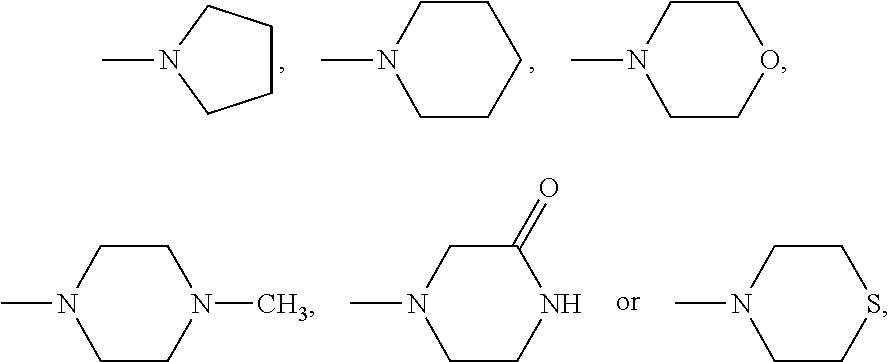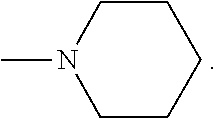Silicon phthalocyanine complex, preparation method and medicinal application thereof
a technology of phthalocyanine complex and phthalocyanine, which is applied in the field of medicine, can solve the problems of skin phototoxicity, poor selectivity and stability of the photodynamic damage strength of the first generation of photosensitizers, and photosensitivity reactions in normal tissues, so as to improve the properties and accessibility
- Summary
- Abstract
- Description
- Claims
- Application Information
AI Technical Summary
Benefits of technology
Problems solved by technology
Method used
Image
Examples
example 1
[0098]
Step 1
[0099]Compound 1-1 (166 g, 1.57 mol) was dissolved in 500 mL of tetrahydrofuran, potassium hydroxide (32 g, 571 mmol) was added in an ice bath, and then p-toluenesulfonyl chloride 1-2 (100 g, 0.52 mol) was added in batches, and the mixture was stirred at room temperature for 5 hours. The reaction solution was poured into 1200 mL of water, (400 mL) and extracted twice with ethyl acetate. The extract liquid was combined and washed with saturated brine, dried over anhydrous sodium sulfate, and concentrated under reduced pressure and purified by silica gel column chromatography, with an eluent (petroleum ether:ethyl acetate=1:1), to obtain the target product 1-3 (55 g, 65%) as a colorless oil, LC-MS: m / z=261 [M+H]+.
Step 2
[0100]Compound 1-3 (5.1 g, 19.6 mmol) was dissolved in 1,4-dioxane (50 mL), followed by addition of methylamine hydrochloride 1-4 (13.4 g, 196 mmol), and potassium carbonate (13.8 g, 100 mmol) was added under stirring in batches, followed by stirring the rea...
example 2
[0102]
Step 1
[0103]Compound 1-3 (3.5 g, 13.5 mmol) was dissolved in 1,4-dioxane (50 mL), followed by addition of ethylamine hydrochloride 2-1 (2.2 g, 27 mmol), and carbonate (3.73 g, 27 mmol) was added under stirring potassium in batches, followed by stirring the reaction overnight under at 70° C., TLC monitoring showed that the starting material 1-3 was completely reacted. The solvent was removed under reduced pressure to obtain a concentrated residue. The concentrated residue was dispensed with dichloromethane (20 mL), an appropriate amount of silica gel was added and the sample was stirred, spin-dried under reduced pressure and directly placed on a silica gel column for column chromatographic purification, with an eluent (dichloromethane:methanol=20 / 1-5 / 1) to obtain the target product 2-2 (1.5 g, 83%) as a pale yellow oil, LC-MS: m / z=134[M+H]+.
Step 2
[0104]Compound 2-2 (201 mg, 1.47 mmol), compound 1-6 (300 mg, 0.49 mmol) and sodium hydride (118 mg, 2.94 mmol, 60% w / w) were added i...
example 3
[0105]
Step 1
[0106]Compound 1-3 (5.7 g, 22 mmol) was dissolved in 1,4-dioxane (60 mL), followed by addition of methoxyethylamine 3-1 (2 g, 27 mmol), and potassium carbonate (3.73 g, 27 mmol) was added under stirring in batches, followed by stirring the reaction overnight at 70° C., TLC monitoring showed that the starting material 1-3 was completely reacted. The solvent was removed under reduced pressure to obtain a concentrated residue. The concentrated residue was dispensed with dichloromethane (20 mL), an appropriate amount of silica gel was added and the sample was stirred, spin-dried under reduced pressure and directly placed on a silica gel column for column chromatographic purification, with an eluent (dichloromethane:methanol=20 / 1-5 / 1) to obtain the target product 3-2 (2.1 g, 58%) as a pale yellow oil, LC-MS: m / z=164[M+H]+.
Step 2
[0107]Compound 3-2 (240 mg, 1.5 mmol), compound 1-6 (445 mg, 0.49 mmol) and 1.5 mL of pyridine were added into a 100 mL reaction flask, then toluene (...
PUM
| Property | Measurement | Unit |
|---|---|---|
| absorption wavelength | aaaaa | aaaaa |
| absorption wavelength | aaaaa | aaaaa |
| wavelength range | aaaaa | aaaaa |
Abstract
Description
Claims
Application Information
 Login to View More
Login to View More - R&D
- Intellectual Property
- Life Sciences
- Materials
- Tech Scout
- Unparalleled Data Quality
- Higher Quality Content
- 60% Fewer Hallucinations
Browse by: Latest US Patents, China's latest patents, Technical Efficacy Thesaurus, Application Domain, Technology Topic, Popular Technical Reports.
© 2025 PatSnap. All rights reserved.Legal|Privacy policy|Modern Slavery Act Transparency Statement|Sitemap|About US| Contact US: help@patsnap.com



